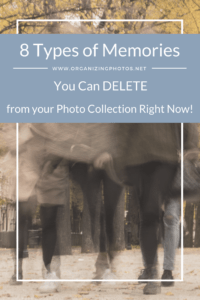Delete is a complicated word. But it’s an important word that we have to get comfortable with as the designated family memory keepers. Many of us, especially those of us who are genealogists, tend to hold on to every little bit of information that we can find. Every shred of evidence that can prove a point. I wanted to write this blog post because I’ve seen so many cluttered collections lately, and the time has come to reflect on this reluctancy to let go of memories we don’t need. I encourage you to think about how you can better curate your memory collection, so that it becomes manageable and usable for future generations. I’ll begin with some suggestions…
Decluttering is Liberating…or is it?
In the world of organizing, the decluttering process is a celebrated one. At least it seems so in the media, doesn’t it? The “out with the old” mantra is strongly woven into the popular consciousness, especially now that the new year is approaching. And it seems that most people who go through this experience, no matter how hard it is, eventually view it as a positive one. Getting rid of old stuff is a crucial part of the organizing puzzle. It’s where you release all that built-up old, stagnant energy and instead welcome in new energy. I’ve heard it described many ways over the years, but I think most people would agree that it’s a very liberating thing. It feels good to let go. It forces you to re-evaluate your priorities and reflect on what’s really important. So far, so good.
Is Your Subconscious Working Overtime?
This positive decluttering experience seems to hold true in everything from clearing your mind to simplifying your home. But there’s something about our photos that stops the momentum dead in its tracks. The minute we think about combining it with our photos, there’s pushback. Why? I think that instinctively we tell ourselves we’re not supposed to delete photos. They’re meant to be saved. Perhaps it’s because this particular type of clutter comes with faces? I suspect that might have something to do with it too. There’s something counterintuitive about deleting a photo of grandma. It’s like she knows what you’re about to do, and that makes you feel guilty. Like somehow you don’t love her enough. Perhaps it’s because we’re taught to think about all our photos as “treasures” from a young age? or maybe it’s because they’re representative of our memories, so we feel that deleting a photo somehow deletes the memory altogether? Not so. In this post, I hope to inspire you to think about your photos differently. Let’s see if I can pull it off.
Why Should We Delete Photos?
Photos are treasures – yes – and they should be saved! You’re right about that, but we need to be more selective in deciding what to keep. Back in the day when you had 24 exposures or less, you were careful about what you took a picture of…right? It had to be a good moment. And you didn’t keep clicking either. It was once (or maybe twice, if the occasion warranted it). This has drastically changed in the last few years.
Your memories have scaled up, and you now take more photos in one sitting than you did in a month a decade or two ago. So it’s important that we delete. The way we handle our memories has to evolve with the times. In the 1800s, you might have only had one photo and chances are it was real easy to take care of it. The trend nowadays is to have so many photos that we can’t handle them. Digital asset management used to pertain mostly to businesses, but I have clients with collections that far surpass that of any business. This shift it culture requires us to react in turn.
The Chain Reaction That Follows
When you use the delete button on a regular basis, something interesting happens: your photo collection actually becomes manageable. That chain reaction allows you to do something with it, like print. Hey, remember when we used to print photos? I bet you haven’t done that in a while (by the way, I’m totally picturing an astonished hush falling over the audience right now! haha!)! You can still do those things, and more, but not with hundreds of thousands of photos. We have to let go of the excess first. So how do we do that? Simple, we curate our photo collections.
What Photos to Delete
So what photos should you delete? Well, that’s really up to you, but I recommend setting some criteria as to what stays and what goes. Before we move on to that part, let me be clear and say that in this post, I’m talking about the photos that come into your camera roll on a regular basis. I’m talking about the excess clutter than no one would miss if it were gone. I am NOT talking about digitized heritage photos or anything like that (despite the Grandma reference; you’ll just have to look past that one!), so please use good judgement when deleting. I don’t want you to get rid of everything! Just don’t be afraid of hitting the delete button when it’s appropriate to do so!
Setting criteria is really simple. Pull out a pen and paper and decide what’s important to you. Make some rules up. Define and document your process, so that you don’t have to come back to the same questions over and over again. What do you need? What don’t you need? You’re a person that’s hard to impress, so make those memories work for it! Excellence is a habit, so if you continuously maintain your collection this way, you’ll become the family hero.
My Criteria for Photos (and Videos) to Delete
Ok, so on to the criteria. You can steal my list if you want, or you can create your own, but here is what I delete on a regular basis (I’ve also thrown in some recommendations for video since the two usually accompany each other nowadays):
1. Out-of-Place Photos
Anything that’s not meant to be in my photo collection permanently goes first, like random screenshots or reminders from yesterday’s shopping trip. I try VERY hard to keep these types of “daily life” photos out of my camera roll consistently, but every now and then something slips through the cracks and needs to be deleted. I’m sure you can relate. It’s so convenient to just grab a quick photo of something instead of writing things down, but the downside is that you create additional work for yourself on the other side of the camera roll.
As a general rule, I recommend that clients try to use something other than the camera roll for reminders (apps like Evernote and Airtable work great), so you cut down on this type of maintenance. At least have someplace to transfer whatever information you’re trying to capture into, so you can subsequently get rid of the visual representation. Otherwise you’re mixing two types of files together: the ones you are keeping permanently, and the ones you won’t be looking at ever again. It may not seem like a big problem now, but 5 years down the line, it’ll be a massive snowball.
2. Mistakes / Blurry Photos
Pressed that shutter button a little too quickly, did ya? Yeah, that happens to all of us. Don’t be shy about deleting all the blurry speed shots that look like you were on a moving train. You’re never going to look at them again. It’s just a waste of good digital storage space. This something you can easily do while waiting in line at the store, or during TV commercials at night. Small power tasks like that go a long way towards staying organized.
The only time a blurry photo gets to stay in my collection is if that photo is the ONLY one I have of the subject in question. A few good examples would be a scanned heritage photo of an ancestor, a once-in-a-lifetime group shot, or a selfie with a cute celebrity. Yep, I got all of those. 😉
3. Bursts / Similar Photos
Do you really need all 10 of those burst shots? I think not. Now don’t get me wrong, I love the burst feature because it makes it so easy to capture a great action shot! This is the thing to use if you’re actually on a moving train! However, once the moment has passed, it’s OK to go back and pick the best photo. That’s what it’s for! So often we forget to do that last bit of work, and we end up with a bunch of “almost great” photos that make it hard to find the good one.
If you’re a Apple Photos user, this is pretty easy to do: go to your bursts collection (auto-populated), click on a set, and pick a winner. They’ve made it really easy for you to screen what you have and select which one you want to keep. The program even prompts you to delete the rest, so you don’t forget that last step. It’s actually one of my favorite things about Apple Photos. Yes, I have a list of favorite things, just like Oprah, and I might share that with you around Christmas time – if you’re nice. Many other programs have similar features, use them! Keep the best, delete the rest.
4. Duplicates / Thumbnails
In the same spirit as bursts, I check for exact duplicates and thumbnails. Sometimes, they sneak in there too. Duplicates are defined as exact copies of photos you already have, and thumbnails are smaller versions photos that are sometimes auto-generated from a program for various reasons.
I generally don’t have any exact duplicates or thumbnails come through my camera roll, but they may show up on my computer if I merge collections or create projects. Every so often, you can run a duplicate check and clean up your library. It’s really simple to do, and it can save you a lot of space on your hard drive.
Keep in mind that if you have different versions of photos, for example sepia or black & white copies, they can be handled differently. No need to delete those if you want them.
5. Unflattering Photos
We all have them. Well, at least most of us. We the people who aren’t photogenic, that is. For every good photo of me there’s at least fourteen bad ones, and they go right into the trash bin. Bad lighting is usually the culprit (at least I like to think so), but it could also just be the general angle or composition.
In most cases, it’s pretty obvious if a photo is flattering or not, but us ladies tend to be hard on ourselves. Don’t delete them all! You want to have a few photos left. It’s a subjective task, but it’s more about deciding what you want to present to the outside world and your descendants when the day comes. How do you want to be remembered? If you’re knee-deep in awkwardness, I see no reason to keep that as a part of your legacy, unless of course that was a major part of your personal brand. In any case, that’s a choice you get to make.
6. “Live” Photo Video Files
Certain smartphones nowadays have what’s called a “live photo” feature, which means that the camera captures a few seconds of video around the photo to showcase the moment better with some fun animation. I am not a fan. Sorry, Apple! Sure, the kids find those videos funny, and I guess they come in handy if you make GIFs on a regular basis, but in my opinion, it just adds to the clutter. Get rid of these types of files if you agree.
I think it’s so annoying to have an accompanying video file (that’s too short to play) for every photo. Ugh. They’re a nightmare to organize because you have to keep them together with their respective photos for them to make sense – they’re too short to play on their own. I normally have that live feature turned off for the sake of sanity. You may disagree, but if you do, just know that there’s additional maintenance involved with that decision.
7. Too-Short Video Clips
Ever start your video by accident when you meant to turn on your panorama? I do that all the time. My fingers just can’t get it right. Well, if you have those types of mistakes in your video collection, they can definitely go. You won’t ever play these types of clips because they’re too short for you to remember the context of what happened. I suppose these types of clips overlap with the previous category too. Anything that’s too short to make sense doesn’t need to stay.
This is another one of those categories that are very subjective, and if you have rare footage of something, it’s OK to keep that even though it might be short. Just like with the other recommendations, one size doesn’t fit all. Use your good judgement when decluttering your collection.
8. Motion-Sickness Video Clips
My video production teacher in college used to say that the zoom feature was only for amateurs. I couldn’t agree more. If you have anything in your video collection that would legitimately qualify as “go-pro” videos when they’re not, think long and hard about whether you want to keep them in your collection. They tend to be fairly unwatchable without getting nauseated.
Since I actually get motion sickness quote often (I can’t read in a car or on a train, for example… Yes, that sucks – thank you for asking!), perhaps I’m a little more sensitive to these videos than the average person would be. I tend to get rid of them right away. If I notice that I’m actually shooting video that’s very bumpy, I stop and try again with a tripod or by setting my camera / phone down somewhere. A steady hand is a learned skill. Unless you’re actually using a go-pro for something like bungy-jumping and it’s meant to be an action video, you are probably safe to delete it. On a boat? Ok, perhaps that gets to stay. But that’s it. No kiddie recitals that look like you were spinning out of control while shooting them. If you have to, buy the DVD!
Upside-down or sideways clips? Keep’em. Those can be turned around.
Delete is Not a Dirty Word!
I think we all need to keep in mind that delete is not a dirty word! Hitting that button is a crucial part of the decluttering process. It’s 100% neccessary in the on-going journey towards organization, and we shouldn’t be afraid of it. When you’re selective, you raise your collection up to a whole new standard. A standard of excellence that will be celebrated by your family members instead of causing them overwhelming anxiety.
If the delete button makes you feel unnerved, remember that you’re not deleting all photos – far from it – and that you just want to get rid of the blah, not the best. Grandma won’t be mad at you for getting rid of unflattering shots of her. She’ll thank you for wanting to portray her in the best of lights. It requires a certain level of trust in yourself, but try it. It’s liberating. It’s how you learn to let go.






Kathy
November 14, 2017 at 1:10 pmHee hee! I, too, have a blurry “photo with celebrity”! I was at the mall with my daughter when we ran into an American Idol finalist and I snapped a (really poor) picture of her with him (Danny Gokey).
Dan
November 14, 2017 at 5:24 pmGood post. This is true for old printed photos too. The why did I take this picture is so important. I just went thru an envelope of prints this morning that we took years ago at the zoo. There were 3 pictures of giraffes. None had any family members on them and none brought back any fond memories. Why I even took 1 giraffe picture – much less 3 – I don’t know but unless I think giraffes will become extinct in the next few years I feel comfortable in tossing all 3 of them.
Caroline Guntur
November 14, 2017 at 7:50 pmHaha! What a great example, Dan! Thanks for sharing!
Brandon Harris
November 23, 2017 at 6:02 amReally a nice blog. Sharing the importance of photo organizing and which photos to keep and which to delete. Thanks for sharing the blog
Caroline Guntur
November 23, 2017 at 11:44 amThanks, Brandon! Glad you enjoy it!
Monique
November 29, 2017 at 2:44 pmI love your blog! It’s true ‘delete’ is not a dirty word! And thank you for reminding me to turn the live-modus off!
Caroline Guntur
November 29, 2017 at 5:13 pmGraag gedaan Monique! 😉
Tanya Napier
December 4, 2017 at 10:10 pmGreat post! I feel like I’m pretty good about deleting, it’s an ongoing process! You mentioned doing a duplicate check…do you prefer a particular program for this? I’ve tried a couple, but haven’t felt confident about the process. Thanks!
Caroline Guntur
December 5, 2017 at 10:04 amHi Tanya! Thanks for your comment! Glad you enjoyed the post! I do have a favorite duplicate sweeper program, and it’s called PhotoSweeper. It’s geared towards Mac finders, so if you’re a PC person, you can use Easy Duplicate Finder. There are many similar ones out there, but PhotoSweeper can’t be beat in my opinion!